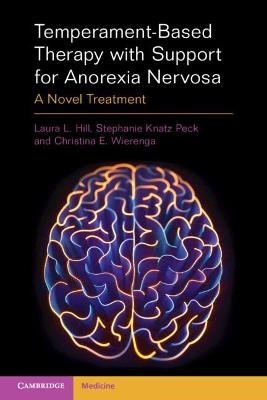
Temperament Based Therapy with Support for Anorexia Nervosa
Cambridge University Press (Verlag)
978-1-009-01680-3 (ISBN)
Anorexia nervosa has one of the highest death rates of all mental illnesses and one of the poorest treatment outcomes. However, one novel treatment, the neurobiologically-based treatment Temperament Based Therapy with Support (TBT-S), works with clients' temperament and traits to motivate change, ultimately managing and reducing symptoms. This practical and accessible book is the first guide to delivering TBT-S that addresses the underlying traits leading to symptoms of anorexia nervosa and helps people to manage symptoms long-term. It offers background information on the role of temperament in anorexia nervosa, the development of the TBT-S protocol and the evidence gathered. Chapters also cover how to use this therapy to augment existing treatment. A valuable resource for clinicians involved in the treatment of anorexia nervosa, including psychologists, psychiatrists, psychotherapists, specialist nurses, dieticians, and educators.
Laura L. Hill is an Adjunct Associate Professor of Psychiatry and Behavioral Health, The Ohio State University, and is also Assistant Clinical Professor in the Department of Psychiatry at the University of California, San Diego. Stephanie Knatz Peck is an Associate Clinical Professor of Psychiatry and Director of Intensive Family Treatments (IFT) and Intensive Temperament Based Treatment at the University of California San Diego. Christina E. Wierenga is a Professor in the Department of Psychiatry at the University of California San Diego.
Introduction; Section 1. Temperament-Based Therapy with Supports (TBT-S) Overview: 1. What is temperament based therapy with supports (TBT-S)?; 2. TBT-S core principles; 3. Overview of TBT-S intervention strategies; 4. State of the evidence base for TBT-S; 5. How to use this manual; Section 2. Setting Up Treatment: 6. How to introduce TBT-S at initial engagement; 7. How to engage supports in treatment; 8. Nuts and bolts for TBT-S modules; Section 3. TBT-S Treatment Interventions: 9. How to deliver neurobiology psychoeducation modules as a motivational strategy; 10. TBT-S neurobiology psychoeducational module: Overview of the neurobiology of anorexia nervosa; 11. TBT-S neurobiology psychoeducation module: Anxiety and interoception; 12. TBT-S neurobiology psychoeducational module: Reward and punishment sensitivity; 13. TBT-S neurobiology psychoeducation module: Decision-making and inhibitory control; 14. Introduction to temperament-based therapy with supports for young adults (YA TBT-S); 15. TBT-S multifamily group format for young adults with AN; 16. TBT-S YA parent skills training module; 17. Young adult TBT-S client skills training module; 18. TBT-S tools to manage and reduce ED symptoms; 19. TBT-S experiential activities; 20. TBT-S strategic dietary approach; 21. Framework for action via TBT-S behavioral agreement; 22. Young adult behavioral agreement (YA-BA); 23. TBT-S behavioral agreement for severe-and-enduring adults with anorexia nervosa (SE-AN); Section 4. TBT-S Augmenting Eating disorder Treatments: 24. Tailoring TBT-S treatment modules into all levels of care; 25. How to apply TBT-S in diverse settings; 26. How to interface TBT-S treatment with ongoing providers and ED programs; 27. Broad application summary of temperament-based therapy with supports: Treat to the traits; Appendix 1. 10 biological facts about anorexia nervosa; Appendix 2. Anxiety brain sculpt: TBT-S experiential activity; Appendix 3. Anxiety wave: TBT-S problem-solving experiential activity; Appendix 4. Young adult “RAD” skills handout: Clients with anorexia nervosa; Appendix 5. Young adult client rules and framework for meals and snacks handout; Appendix 6. Young adult behavioral agreement (YA BA); Appendix 7. Young adults: Emerging adulthood handout; Appendix 8. Parenting young adults with anorexia nervosa: Providing parental assistance in developmentally appropriate ways handout; Appendix 9. Brainwave: TBT-S neurobiological experiential activity; Appendix 10. Charades: TBT-S neurobiological problem-solving experiential activity; Appendix 11. Neurobiology experiential activity YES/NO game; Appendix 12. Communicating and listening young adult TBT-S experiential activity: Addressing family relationships; Appendix 13. Family circuits: TBT-S experiential activity addressing communication and family structure; Appendix 14. Family wise mind: Young adult TBT-S experiential activities addressing communication and family relationships; Appendix 15. Expert client advice: TBT-S experiential activity; Appendix 16. Landmine: TBT-S problem-solving experiential activity; Appendix 17. Nondominant hand: TBT-S neurobiological and problem-solving experiential activity; Appendix 18. Neuron activity: Why food and support are needed TBT-S neurobiological experiential activity; Appendix 19. Social gauntlet: TBT-S problem-solving experiential activity; Appendix 20. Stop, reboot, reroute: TBT-S problem-solving experiential activity; Appendix 21. Telephone: TBT-S neurobiological experiential activity; Appendix 22. What will you do? TBT-S problem solving experiential activity; Appendix 23. Wire-rewire: TBT-S neurobiological problem-solving experiential activity; Appendix 24. TBT-S tool-box; Appendix 25. TBT-S trait profile checklist; Appendix 26. SE-AN behavioral agreement; Appendix 27. Young adult TBT-S treatment targets matched with skills handout; Appendix 28. Par
| Erscheinungsdatum | 21.04.2022 |
|---|---|
| Zusatzinfo | Worked examples or Exercises |
| Verlagsort | Cambridge |
| Sprache | englisch |
| Maße | 156 x 233 mm |
| Gewicht | 570 g |
| Themenwelt | Geisteswissenschaften ► Psychologie ► Klinische Psychologie |
| Medizin / Pharmazie ► Medizinische Fachgebiete ► Psychosomatik | |
| Medizin / Pharmazie ► Medizinische Fachgebiete ► Psychiatrie / Psychotherapie | |
| ISBN-10 | 1-009-01680-6 / 1009016806 |
| ISBN-13 | 978-1-009-01680-3 / 9781009016803 |
| Zustand | Neuware |
| Informationen gemäß Produktsicherheitsverordnung (GPSR) | |
| Haben Sie eine Frage zum Produkt? |
aus dem Bereich


